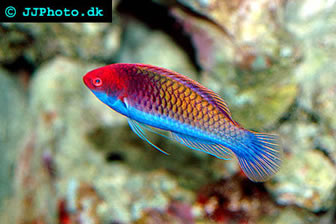Solar Fairy Wrasse
Cirrhilabrus solorensis
Common name: Solar fairy Wrasse, Tricolor Fairy Wrasse, Solar Wrasse, Clown Fairy Wrasse, Red Head Wrasse, Solorensis Fairy Wrasse
Scientific name: Cirrhilabrus solorensis
Max size: 5 in / 12.5 cm
pH: 8.1-8.4
Salinity: 1.020-1.025
Temperature: 72-82ºF (22-28°C)
The Solar fairy wrasse is just like most other fairy wrasses a truly stunning fish. The male fish sports a large numbers of colors. He has a yellow head, while the top of the body as well as his tail and dorsal fin are red. He also has a big green blue field on his body and the pelvic fins often sport some purple. The females are reddish in color with blue fins, except for the dorsal fin which is reddish as well. The body shape of this species is elongated and similar to that of Apistogramma dwarf cichlids. They are cheaper than some other commonly kept fairy wrasses.
The Solar fairy wrasse originates from the west Pacific Ocean and the eastern Indian Ocean, and is primarily found in the waters surrounding Indonesia and Bali.
The Solar fairy wrasse adapts well to captivity and is easy to care for. It is small, very colorful, hardy, and friendly towards other fishes which make it an ideal saltwater and reef aquarium fish. It is somewhat suitable as a beginner fish even though there are other cheaper fish species such as many damsels that can be said to be better beginner fish for those who want to keep their first saltwater aquarium. Aquarists that have kept saltwater species for a while should not have any trouble caring for this fish.
Males are aggressive towards other males and you should therefore only keep one male in the same aquarium unless it is a very big (180 gallon+) tank. Females are friendly towards each other and you can keep several females in the same tank.
Solar fairy Wrasse care and aquarium setup:
The Solar fairy wrasse should not be kept in a tank smaller than 30 gallon / 120 L. They are 100% reef safe and will not touch corals or other invertebrates. They prefer a setup with a lot of hiding places among live rock but it is important to preserve some open areas as well. Live rock is not necessary for keeping this species as long as they are given enough hiding places. If there aren't enough hiding places in the aquarium they can become very shy and hide most of the time. If there are enough hiding places they will almost always be out swimming in the open. The aquarium should be well circulated with some calmer areas. They like a lot of light but want there to be darker areas in the setup as well.
You should never introduce new females to an aquarium with a male Solar fairy wrasse. Any and all females should be introduced before or at the same time as the male. The male might otherwise become very aggressive towards the new female.
Ideal water conditions are pH 8.1-8.4, salinity 1.020-1.025, and temperature 72-82ºF (22-28°C).
Feeding Solar fairy Wrasse
The Solar fairy Wrasse is just like most other fairy wrasses easy to feed. Most specimens can be trained to accept high quality flake food and flake food can be used as the foundation of a good diet for Solar fairy wrasses. You should however not feed them just flake food as they do best on a varied diet including frozen food and chopped sea food. They are carnivores and should be given a high protein diet. Feed them 3-4 times a day. Young specimens might fade away or become very sensitive if they aren't fed often enough.
Breeding Solar fairy Wrasse
Solar fairy wrasses are easy to sex as males are more colorful than females and tend to have more elongated fins. The females are brown red with blue fins while the males show a lot of different colors with plenty of green on the body. If you keep a Solar fairy wrasses, odds are that it is male as almost all fishes offered in the trade are male. This is due to the fact that only males feature the coloration that has made this species popular. Your local fish store can however likely order females for you if you want. We have no info on breeding this species, but it is likely a harem spawner which means that you should get one male and several females if you want to try to breeding Solar fairy wrasses. A good diet and good water quality is likely also very important.

Solar wrasse. Picture by ILuvMyGoldbarb
Wrasse Articles:
Bird Wrasse – Gomphosus varius
Dragon Wrasse - Novaculichthys taeniourus
Harliquin Tuskfish – Coerodon fasciatus
Hogfish - Information about Hogfish
Neon Wrasse – Halichoeres melanurus
Ornate Wrasse – Halichoeres ornatissimus
Queen Coris – Coris frerei
Radient Wrasse – Halichoeres iridis
Spanish Hogfish – Bodianus rufus
Striated Wrasse – Pseudocheilinus evanidus
Yellow Coris – Halichoeres chrysus
Line Wrasses:
Fourline Wrasse – Pseudocheilinus tetrataenia
Sixline Wrasse – Pseudocheilinus hexataenia
Eightline Wrasse – Pseudocheilinus octotaenia
Fairy Wrasses:
Exquisite Fairy Wrasse – Cirrhilabrus exquisitus
Lubbock's Fairy Wrasse – Cirrhilabrus lubbocki
Scott's Fairy Wrasse – Cirrhilabrus scottorum
Flasher Wrasses:
Carpenter's Flasher Wrasse – Paracheilinus carpenteri
Dot-and-Dash Flasher Wrasse – Paracheilinus lineopunctatus
Filamented Flasher Wrasse – Paracheilinus filamentosus
McCosker's Flasher Wrasse – Paracheilinus mccoskeri

